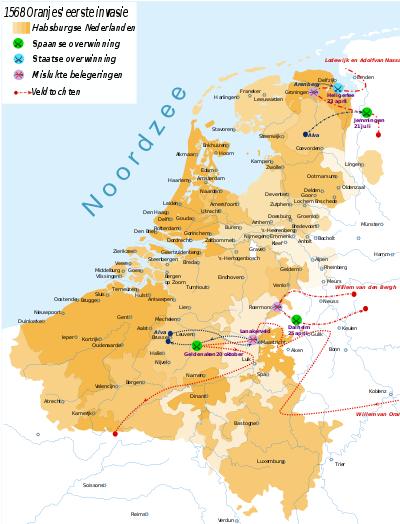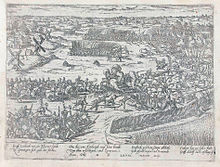Eighty Years' War
Eighty Years' War

The sack of Antwerp by the Spanish troops
Eighty Years' War
Western Europe
Oosterweel - Dahlen - Heiligerlee - Jemgum - Jodoigne - Le Quesnoy - Brielle - Mons - Goes - 1. Mechelen - Naarden - Middelburg - Haarlem - Alkmaar - Geertruidenberg - Leiden - Delft - Valkenburg - Mooker Heide - Schoonhoven - Zierikzee - 1. Antwerp - Gembloux - Rijmenam - 1. Deventer - Borgerhout - 1. Maastricht - 2. Mechelen - 1. Steenwijk - Kollum - 1. Breda - Noordhorn - Niezijl - Lochem - Lier - Eindhoven - Steenbergen - Ghent - Aalst - 2. Antwerp - IJsseloord - Empel - Boksum - 1. Grave - 1. Venlo - Axel - Neuss - 1. Rheinberg - Zutphen - 1. Sluis - 1. Bergen op Zoom - 2. Geertruidenberg - 2. Breda - 2. Zutphen - 2. Deventer - Delfzijl - Knodsenburg - 1. Hulst - Nijmegen - Rouen - Caudebec - 2. Steenwijk - 1. Coevorden - 3. Geertruidenberg - 2. Coevorden - Groningen - Huy - 1. Groenlo - Lippe - Calais - 2. Hulst - Turnhout - 2nd Rheinberg - 1st Moers - 2nd Groenlo - Bredevoort - Enschede - Ootmarsum - 1st Oldenzaal - 1st Lingen - 1st Schenckenschans - Zaltbommel - Rees - San Andreas - Nieuwpoort - 3rd Rheinberg - Ostend - 1st 's-Hertogenbosch - 2nd Grave - Hoogstraten - 3rd SluisTwelve Years
Peace2
. Lingen - 3. Groenlo - Aachen - Jülich - 2. Bergen-op-Zoom - Fleurus - 3. Breda - 2. Oldenzaal - 4. Groenlo - 2. 's-Hertogenbosch - Slaak - 2. Maastricht - Leuven - 2. Schenkenschans - 4. Breda - 2. Venlo - Kallo - 3. Hulst
European watersVlissingen
- Borsele - Haarlemmermeer - Zuiderzee - Schelde - Lillo - Ponta Delgada - Bayona Islands - Gulf of Almería - 1st Cadiz - Azores - Strait of Dover - 2nd Sluis - 1st Cape St Vincent - 1st Gibraltar - 2nd Gibraltar - 2nd Cadiz - Lizard Point - Dunkirk - Calais - Downs - 2nd Cape St Vincent - 2nd St Martin
AmericaBahia
- Matanzas - St. Martin - San Juan - Abrolhos - Pernambuco - South Chile
East IndiesPlaya
Honda - 1st San Salvador - 2nd San Salvador - La Naval de Manila - Puerto de Cavite
In the Eighty Years' War (also Spanish-Dutch War, Spanish guerra de Flandes, Dutch Tachtigjarige Oorlog) from 1568 to 1648, the Republic of the Seven United Provinces won its independence from the Spanish crown and thus from the House of Habsburg. With its end, the northern Netherlands left the federation of the Holy Roman Empire. The southern part of the Netherlands, on the other hand, remained with Spain: Belgium emerged from it in the 19th century. The Netherlands was thus permanently divided.
The war developed from an uprising of the Dutch against the Spanish and Catholic sovereign Philip II, which was mainly started by Calvinists. After the Spaniards had been able to avert the first uprising, unrest developed again from 1572 onwards, which gradually spread throughout the country. With the exception of the Twelve Years' Truce in the period from 1609 to 1621, the fighting continued until 1648. Finally, Spain officially recognized the independence of the northern Netherlands in the Peace of Westphalia.
Previous story
Before the war, the Netherlands, which at the time included what is now the Netherlands as well as Belgium, Luxembourg and part of northern France, belonged to the Holy Roman Empire and was ruled by the Spanish branch of the Habsburgs. They consisted of 17 provinces. Around the middle of the 16th century, Calvinism spread in the Netherlands as a result of the Reformation. The Netherlands represented a major economic power at the time. Antwerp was a center of the European capital market. Antwerp and Rotterdam, through their ports, were also important transhipment points for trade in goods from overseas and the new colonies in South America. Because of this concentrated economic power and because of the important strategic location, the Spanish Habsburgs were unwilling to release the Netherlands from their possession.
Philip II took over the rule of the Netherlands in 1555 from his father Charles V. He continued even more consistently the persecutions of heretics (Inquisition) that had already begun under the latter and had caused unrest in the Netherlands. In 1559, in the course of an ecclesiastical reorganization, he appointed new bishops who were also to be represented in the Estates General of the provinces, the so-called States General, and reduced the size of the bishoprics. In this way, Philip wanted on the one hand to intensify the Counter-Reformation, but on the other hand also to reverse the estates freedoms that had been granted to the provinces in the "Great Privilege" of 1477. He appointed his half-sister Margarethe of Parma as governor in the Netherlands and placed the Bishop of Mechelen, Cardinal Antoine Perrenot de Granvelle, at her side as first minister. Philip himself went back to Spain in 1560; in 1561 he then also withdrew his troops from the Netherlands.
The Dutch struggle for independence
Some members of the Dutch Council of State, led by William I of Orange and the counts of Egmond and Hoorn, protested vehemently against these changes and forced Granvelle's resignation in 1564. In a petition known as the "Compromise of the Nobility of Breda", the rebels (who called themselves "Geuses", translated: "beggars") explicitly demanded that the governor Margaret of Parma end the Inquisition and the persecution of Protestants and restore their estates' liberties.
The protest against Spanish rule reached a first climax in the same year with the iconoclasts of the Calvinists. Philip then abolished the Inquisition, but in 1567 he sent the Duke of Alba, Fernando Álvarez de Toledo, as the new governor with Spanish troops on a punitive expedition to the Netherlands. Alba also initially succeeded in suppressing the regional uprisings with the help of a special court, the so-called Blood Council of Brussels. In the process, more than 6000 rebels were executed, among them the counts of Egmond and von Hoorn. In the same year, Alba also defeated the Dutch troops led by William I of Orange.
With his ruthless and arbitrary actions, however, Alba provoked new uprisings by the Dutch. If until then the unrest had been mostly regional and still largely uncoordinated, the uprising now encompassed the entire country. However, the claim that the Congregation of the Roman and General Inquisition under Pope Pius V, in a decree of February 16, 1568, had in effect condemned all of the approximately three million Dutch to death for heresy, exempting only a few named individuals, is based on a forgery.
In a secret diplomatic conference held at Freudenberg Castle (in the Siegerland region of southern Westphalia) from April 2 to 4, 1568, a delegation of the nobles of Gelderland was promised military support in the struggle against Spain by William I of Orange. The Eighty Years' War began with the first military clash between the two sides at the Battle of Heiligerlee in 1568, in which Adolf of Nassau, brother of William of Orange, fell.
Especially the Dutch privateers called "Wassergeusen" made the Spaniards' life difficult with their continuous attacks on sea transports and bases. In 1572 they achieved their greatest success when they conquered the provinces of Zeeland and Holland. William I of Orange was chosen as governor of the liberated provinces, effectively giving him the leadership of the resistance against Spain.
In 1573, Alba was replaced by Don Luís de Zúñiga y Requesens. Although the new governor was initially more successful than his predecessor, the rebels once again achieved a great victory: they flooded the country, sailed to Leiden and liberated the city from the Spanish besiegers (Siege of Leiden). Together, all SeventeenProvinces formulated their demands for the withdrawal of Spanish troops and religious tolerance in the "Ghent Pacification" (1576). It was ratified by the States General in Antwerp. The new Spanish governor Don Juan de Austria, a half-brother of King Philip II. , formally accepted the demands, yet unrest continued. The Ghent Pacification was to be the last joint act of the Seventeen Dutch Provinces.

The Liberation of Leiden (1574), stained glass from the Sint Janskerk in Gouda (1603)

Places of important military conflicts in 1568

The Battle of Heiligerlee (1568) in a contemporary account
Search within the encyclopedia